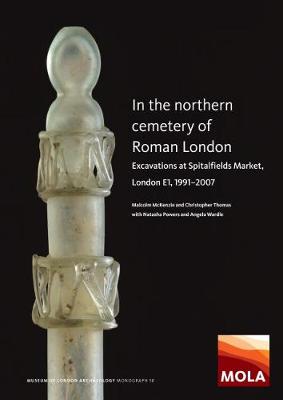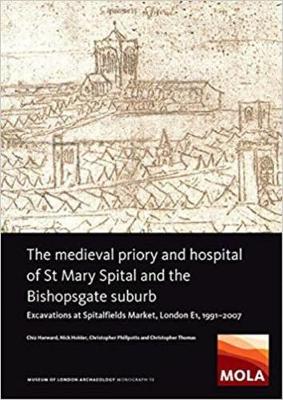MOLA monograph
2 primary works
Book 58
In the Northern Cemetery of Roman London
by Malcolm McKenzie and Christopher Thomas
Published 28 October 2020
London’s Spitalfields Market was the location of one of the city’s largest archaeological excavations, carried out by MOLA between 1991 and 2007. This book presents the archaeological and bioarchaeological evidence for Roman activity here, to the north-east of the urban settlement and the site of a series of burial grounds on the east side of Ermine Street. Burial began here c AD 120 and continued into the 4th century AD. Excavation revealed a number of ditched enclosures, some used for the interment of 169 inhumations and five cremation burials, some for other purposes. Among the early burials men outnumbered women by five to one, but by the later 3rd and 4th centuries AD a more even sex ratio prevailed. Subadults were well represented, with one area apparently set aside for the burial of neonates and children. The cemetery attracted some particularly wealthy 4th-century AD burials, including at least two in stone sarcophagi, one of which contained an inner, decorated, lead coffin enclosing a young woman. She had been anointed with imported resins and buried in fine clothing, with unusual glassware and jet items. Some burial rites and grave goods are more familiar from Continental cemeteries, emphasising the cosmopolitan and mobile nature of London’s population.
Book 59
The Medieval Priory and Hospital of St Mary Spital and the Bishopsgate Suburb
by Chiz Harward, Nick Holder, Christopher Phillpotts, and Christopher Thomas
Published 30 March 2019
London’s Spitalfields Market was the location of one of the city’s largest archaeological excavations, carried out by MOLA between 1991 and 2007. This book presents the archaeological and documentary evidence for medieval activity here, on the north-eastern fringe of the historic city, and the site of the Augustinian priory and hospital of St Mary without Bishopsgate, later known as St Mary Spital.
Large areas of the medieval precinct have been explored, making this by far the most intensively investigated medieval hospital, and one of the most extensively investigated monastic establishments, in Britain. Founded in 1197, rebuilt on a larger scale and refounded in 1235, the hospital catered primarily for London’s sick poor. A pre-existing extramural and extraparochial cemetery became the priory’s principal cemetery. As the priory continued to attract patrons and wealth, it expanded its precinct and carried out major building programmes. By the 15th century the small hospital had become one of the largest Augustinian priories in southern England. Medical treatment in the 14th century is illustrated by remarkable evidence from the canons’ infirmary with its attached pharmacy; a trend towards secularisation in the 14th and 15th centuries is shown by the hamlet of timber houses and workshops that grew around the cemetery. An exceptional survival was the charnel crypt of the 14th-century cemetery chapel, which is preserved today under Bishops Square.
Large areas of the medieval precinct have been explored, making this by far the most intensively investigated medieval hospital, and one of the most extensively investigated monastic establishments, in Britain. Founded in 1197, rebuilt on a larger scale and refounded in 1235, the hospital catered primarily for London’s sick poor. A pre-existing extramural and extraparochial cemetery became the priory’s principal cemetery. As the priory continued to attract patrons and wealth, it expanded its precinct and carried out major building programmes. By the 15th century the small hospital had become one of the largest Augustinian priories in southern England. Medical treatment in the 14th century is illustrated by remarkable evidence from the canons’ infirmary with its attached pharmacy; a trend towards secularisation in the 14th and 15th centuries is shown by the hamlet of timber houses and workshops that grew around the cemetery. An exceptional survival was the charnel crypt of the 14th-century cemetery chapel, which is preserved today under Bishops Square.

